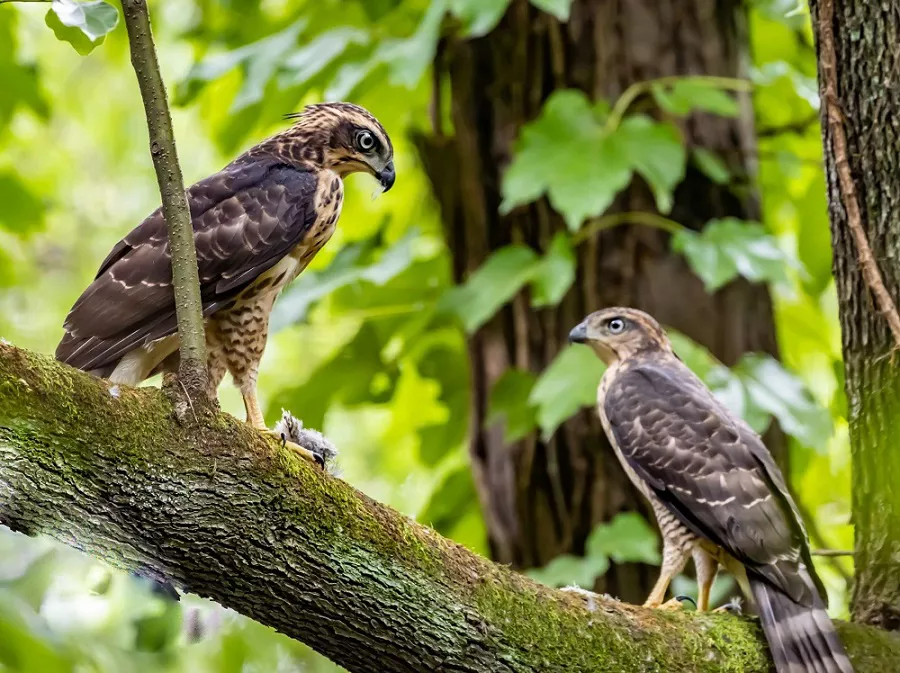The crested goshawk (Accipiter trivirgatus) is a bird of prey from tropical Asia. It is mouse gray from the forehead to the back of the neck, with prominent crest feathers of the same color as the head, the rest of the upper body is brown, and the tail has 4 broad dark horizontal spots. Throat white, chest brown, with white longitudinal stripes, rest of lower body white, with narrow brown horizontal spots.
What does Crested goshawk look like
The Crested goshawk is a medium-sized bird of prey, with black-gray forehead, crown, back pillow and crest; the head and sides of the neck are lighter, with black quills. The upper body is dark brown, and the tips of the tail coverts are white; the tail is light brown, with white end spots, a hidden and not very conspicuous horizontal band and 4 exposed dark brown horizontal bands; the flight feathers also have dark brown horizontal bands, and the inner Basal part white. The chin, throat and chest are white, the chin and throat have a dark brown central longitudinal stripe; the chest has a wide brown longitudinal stripe, the undertail coverts are white; the lower part of the chest has dark brown and white alternately arranged horizontal spots. The iris is golden yellow, the corners of the mouth are brown or lead, the peak and tip of the mouth are black, the corners of the mouth are yellow, the cere and eyelids are yellowish green, the feet and toes are light yellow, and the corners of the claws are black.
The juvenile bird’s upper body is dark brown, with a tea-yellow feather margin, the nape of the neck is tea-yellow, with a slight black spot; the head has a wide tea-yellow feather margin. Lower body skin yellowish white or light brown or white, throat with black central longitudinal stripes, chest and abdomen with black longitudinal stripes or longitudinal black spots.
There is an arc-shaped overhang on the edge of the upper beak, which is suitable for tearing and swallowing prey; the base has cere or beard-like feathers; the wings are strong, wide, round and blunt. Most of the metatarsus are relatively long, approximately equal to the length of the tibia. Females are significantly larger than males.
Crested goshawk habitat
The Crested goshawk is a resident bird, usually inhabiting montane forests and foothill forest margins below 2,000 meters and up to 2,400 meters above sea level. It also occurs in bamboo forests and small areas of jungle, and occasionally moves to the plains at the foot of mountains and near villages. It is alert and good at hiding. It often hides in the leaves, and sometimes perches on isolated branches in open spaces.
Crested goshawk living habit
It is good at hiding and alert, and often hides in the leaves, and sometimes perches on isolated branches in open spaces. sunrise sex. It mostly moves alone, flies slowly, and is not very high. Sometimes it also uses the rising thermals to hover and soar in the air. When hovering, the wings often press down and shake. Territorial is very strong.
What does Crested goshawk eat
It mainly feeds on animal food such as frogs, lizards, rodents, and insects, and also eats birds and small mammals. It mainly preys on the ground in the forest, often hides among the branches, and only strikes suddenly when it finds its prey. The bark is quieter, a he-he-he-he-he-he screech and a drawn-out bark.
Distribution area of Crested goshawk
Origin: Bhutan, Brunei, Cambodia, China, India, Indonesia, Laos, Malaysia, Myanmar, Nepal, Philippines, Singapore, Sri Lanka, Thailand and Vietnam.
Traveling Bird: Bangladesh.
Mode of reproduction
The breeding season is from April to July. During the breeding season, it often soars over the forest and makes loud calls at the same time. It nests on tall trees in coniferous forests or broad-leaved forests, 6-30 meters above the ground. The nest is rough, mainly made of dead branches, with some green leaves inside. Nesting locations are mostly on the banks of rivers or beside ponds, not far from the water. If breeding is successful, the nest will continue to be used next year. Each nest usually lays 2-3 eggs, the eggs are oval, and the size is 43-54 mm × 37-41 mm. They are extremely territorial during incubation, sometimes even attacking those who enter the nest.


 Facebook
Facebook  Instagram
Instagram  Youtube
Youtube 